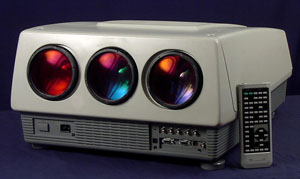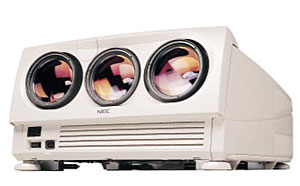 |
CRT Primer
|
Updated: April 2006 |
NEC
The first version of NEC CRT projector that I am familiar with is the
1988-1990 DP-1200. This is a video projector with EM focus 7” tubes, and puts
out 475 lumens. A fairly compact and reliable projector, this one is a challenge
to set up and converge, but if you follow the instructions, you will get the
hang of it. It uses digital convergence in conjunction with a wired or wireless
remote control, and these remotes have been discontinued and are hard to find,
whereas the projectors are relatively common. The tube life is exceptionally
long in this projector model to the fact that they were not being driven very
hard. At this point however (2005), the sets are starting to fail simply due to
the age of the components, and I have stopped selling them.
The GP-3000 and GP-5000 came out in 1990 to about 1992. The GP-300 was a 7”
EM focus and the GP-5000 was a 9” projector. Both had digital convergence
similar to the DP-1200, and they were rated at 600 and 650 lumens respectively.
Again, a little hard to converge and set up, but they were a stable projector
once they were set up. the wired or wireless remotes are mandatory for the set
up of this projector. Currently NEC does not support the above projectors, and
all parts must be obtained on the surplus market.

NEC 9PG Xtra
In 1993, the PG series of projectors
came out, this included the 6 PG, the 6
PG Plus, the 6 PG Xtra and the 9 PG, 9
PG Plus, PG Xtra, and the 10 PG.
The base model 6 and 9 PG were 7” EM
focus with 800 lumens, and digital
convergence, The basic 6 PG only had RGB
inputs; the video and S-video inputs
required an optional video card. the 6
PG scans to 60 Khz, the 9 PG to 90 Khz.
The 9 PG came with a point convergence
card that allowed fine tuning of the
convergence parameters. The 9 PG also
came with the optional video and S-video
card.
The 6 and 9 PG Plus had slightly higher
scanning rates of 64 and 94 Khz, and had
a higher video bandwidth for a slightly
improved picture. Additional electronic
astigmatism circuits were added for
better control of focusing over the
plain PG model.
The 6 and 9 PG Xtra used different picture tubes that offered 1000 lumens
instead of the 800 lumens of the basic models. Short of going to a true 8”
projector (read… more expensive), the NEC PG Xtra is the highest performing and
most compact set that comes about 85% of an 8” projector.
NEC also released the 9" EM focusing 10 PG. They are considerably
larger and rarer than the other PG units.
Again, the NEC’s needed the wireless
remote to set the projector up. These
are currently still available from NEC.

NEC XG-135LC
In late 1996 the XG series of projectors
replaced the PG line. The XG models came
out as the XG 75, 85, 110 and 135. The
number within the model number indicated
the max scan rate of the projector, so
the XG-75 was 75 Khz, etc. True 8” EM
focus tubes, video, S-video and RGB
inputs, digital convergence, and 1200
lumens. One of my favourite projector
series of all time due to their great
fleshtones.
Lots of convergence parameters to set
up, which result in an excellent
picture.
The XG-110 and XG-135 also came in a
liquid coupled version, which is harder
to find than the non LC version. The LC
adds a layer of fluid between the tube
surface and the lens, giving more
contrast to the picture, but reducing
the brightness slightly. These LC tubes
are also more expensive than the non LC
versions.
NEC strengths and weaknesses
All NEC projectors in general are very reliable, with the exception of the
GP-3000 which are now known for sudden power supply failures. There is a custom
chip in the GP-3000 power supplies that has long been discontinued, and when
that chip blows, the power supply is a write off. Working supplies are hard to
come by on the surplus market.
NEC in general used an outside vendor for all of their power supplies, and
are therefore sold as a whole assembly from NEC. Fortunately, failures of other
than the GP-3000 power supply appear to be rare.
The NEC PG and XG series occasionally has failures of the convergence and
focus output board as well as the deflection board, but these boards are easily
and cheaply repaired.
The NEC XG model’s weak spot is the HV power supply. While failures
themselves are rare, you simply cannot swap out the failed XG board with another
unit, as the HV settings are determined not only by the HV board, but by the HV
quadrupler and splitter and internal settings of the set. Fortunately, the
failures of the HV board are usually simple for a tech to find. The swapping of
the HV board in a XG projector requires a recalibration of the HV section, and
needs a HV probe, something that the average CRT owner does not have access to.
The factory setting of the throw distance between the projector and screen is
set slightly higher than with other projector models. This results in somewhat
faster tube wear than normal, as a lower area of phosphor is used than with
other models. I generally recommend that NEC projectors are installed 7% closer
to the screen than the factory manual tells you, and that prevents premature
tube wear.
In general however, NEC’s are an excellent bet as a used projector.
|
|



